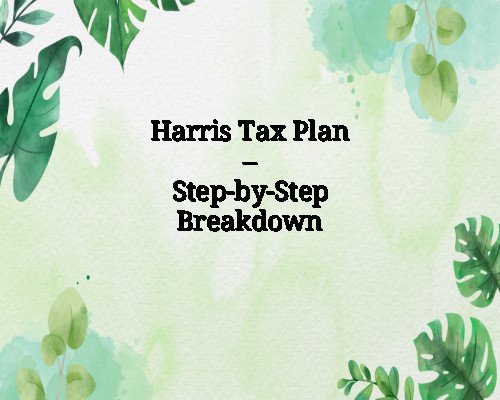Harris Tax Plan – Step-by-Step Breakdown
Discover how the Harris Tax Plan proposes to reshape taxation with progressive reforms, simplified brackets, and incentives that target middle-class growth.
Understanding the Basics of the Harris Tax Plan
The Harris Tax Plan is a progressive, reform-oriented approach to federal taxation, designed to address income inequality, simplify the tax code, and fund essential social programs. Proposed by Senator Kamala Harris, the plan emphasizes tax fairness by increasing the burden on higher-income individuals and providing meaningful relief to working and middle-class families.
The central theme of the Harris Tax Plan is to rebalance the tax system to benefit 90% of Americans while targeting the wealthiest top earners for increased contributions.
Step 1: Expanding the Earned Income Tax Credit (EITC)
One of the key pillars of the Harris Tax Plan is an aggressive expansion of the Earned Income Tax Credit.
Key Features:
-
LIFT the Middle Class Act: This initiative would provide up to $6,000 per year in refundable tax credits for individuals and families.
-
Immediate Relief: Eligible households could receive up to $500 per month directly.
-
Broader Eligibility: It extends benefits to single adults without children, a group traditionally underserved by EITC.
Impact:
This step is designed to lift millions of Americans out of poverty by directly increasing their disposable income. The monthly payment structure also helps households manage ongoing expenses such as rent, groceries, and utilities.
Step 2: Tax Increases for High-Income Earners
To fund expanded social benefits and correct growing income disparities, the Harris Tax Plan proposes a series of tax hikes for the wealthiest Americans.
Details:
-
New Tax Brackets: Additional brackets would be introduced for individuals earning more than $500,000 and couples earning over $1 million.
-
Marginal Tax Rates: The top marginal tax rate could climb above 40% for ultra-wealthy earners.
-
Capital Gains Alignment: The plan suggests treating capital gains and dividends as regular income for those earning above certain thresholds.
Purpose:
This ensures that the wealthiest contribute a fair share toward funding government programs that support education, healthcare, and infrastructure. By targeting passive income sources like capital gains, the plan addresses systemic loopholes exploited by high-net-worth individuals.
Step 3: Corporate Tax Reform
Corporate taxation is another cornerstone of the Harris Tax Plan, which aims to make multinational corporations pay a larger share of taxes and close existing loopholes.
Major Proposals:
-
Corporate Tax Rate Increase: The corporate tax rate would be raised from 21% to 28%.
-
Global Minimum Tax: Introduce a 15% minimum tax on global profits to prevent profit-shifting to offshore tax havens.
-
Limiting Deductions: Certain deductions for executive compensation and stock buybacks may be curtailed.
Outcome:
These reforms are expected to generate substantial revenue while disincentivizing tax avoidance behaviors and promoting domestic reinvestment by large corporations.
Step 4: Tax Simplification and Compliance
The Harris Tax Plan also aims to simplify the tax filing process and make compliance more transparent and affordable for the average American.
Simplification Measures:
-
Pre-Filled Tax Returns: The IRS would provide pre-filled forms to taxpayers based on third-party data.
-
Free Filing Options: Expand free e-filing services for individuals earning less than $100,000 annually.
-
Audit Reform: Increase IRS funding to audit high-income households more effectively.
Benefit:
These measures would save time and reduce the cost of tax preparation, particularly benefiting low- and middle-income filers. Enhanced IRS oversight would also close the enforcement gap, which disproportionately benefits the wealthy.
Step 5: Incentives for Working Families
The plan includes several new deductions and credits targeting middle-income earners, especially families with children.
Key Incentives:
-
Childcare Tax Credit: Expand the credit to cover up to $8,000 for one child or $16,000 for two or more children.
-
First-Time Homebuyer Credit: Provide up to $15,000 for qualifying buyers to help increase homeownership rates.
-
Education Deductions: Expand tax deductions for student loan interest and tuition expenses.
Overall Goal:
These incentives reduce the cost of living for working families and encourage economic participation. By relieving financial stress, families can invest more confidently in housing, education, and healthcare.
Step 6: Wealth Tax Considerations
While not officially part of the core proposal, Harris has signaled openness to evaluating wealth tax models proposed by economists and other policymakers.
Hypothetical Elements:
-
Annual Wealth Tax: A potential tax on net worth above $30 million, starting at 1% annually.
-
Luxury Taxation: Increased excise taxes on private jets, yachts, and other high-end luxury items.
Long-Term Impact:
Though still theoretical, these additions could provide long-term funding streams for public investments in infrastructure, green energy, and education.
Step 7: Environmental and Green Energy Credits
In alignment with climate goals, the Harris Tax Plan introduces tax credits aimed at encouraging sustainable behaviors.
Environmental Provisions:
-
Green Home Upgrades: Credits for solar panel installations, energy-efficient appliances, and home insulation.
-
Electric Vehicle Incentives: Increased subsidies for EV purchases and related infrastructure.
-
Corporate Sustainability Credits: Businesses that invest in green technologies or cut emissions would qualify for tax benefits.
Result:
These initiatives incentivize environmental responsibility while supporting new industries and job creation in the clean energy sector.
Step 8: Revenue Estimates and Budget Impact
Nonpartisan projections estimate that the Harris Tax Plan could raise over $2 trillion in revenue over a decade, primarily from high-income earners and corporations.
Revenue Allocation:
-
Universal Pre-K and Childcare
-
Student Debt Relief
-
Medicaid Expansion
-
Housing Subsidies
-
Green Infrastructure Projects
Fiscal Responsibility:
While the plan is ambitious, the proposed tax increases are structured to avoid expanding the federal deficit significantly. Strategic investments in education and healthcare are projected to yield long-term economic growth.
Step 9: Criticisms and Concerns
No tax plan is without controversy, and the Harris Tax Plan has drawn critique from various quarters.
Main Critiques:
-
Disincentivizing Investment: Higher taxes on capital gains might reduce investment in innovation and startups.
-
Complex Enforcement: Implementing a wealth tax or global minimum tax could be administratively challenging.
-
Political Resistance: Opposition from Republicans and some moderate Democrats may stall legislative progress.
Counterpoints:
Supporters argue that fair taxation and public investment will create a more resilient, equitable economy and ultimately foster stronger long-term growth.
Step 10: What It Means for You
For most Americans earning under $100,000 per year, the Harris Tax Plan would likely result in:
-
Higher Refunds or Monthly Credits
-
Lower Overall Tax Liability
-
Easier Tax Filing
-
Increased Support for Childcare, Education, and Healthcare
For high earners and corporations, it signals a shift toward progressive taxation designed to rebalance decades of economic disparity.
Conclusion
The Harris Tax Plan is a bold blueprint that reimagines the American tax system. It prioritizes working families, demands more from the ultra-wealthy, and addresses systemic loopholes that have long benefited a small elite. While the path to full implementation may be complex, the plan offers a clear, structured vision for a fairer and more functional tax landscape.

